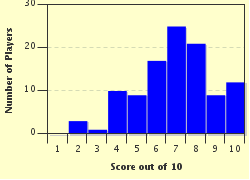Quiz Answer Key and Fun Facts
1. Most people know that Jesus' first miracle was turning water into wine. But which New Testament figure advised his friend to "Drink no longer water, but use a little wine for thy stomach's sake and thine often infirmities"?
2. Wine was so important to the ancient Greeks that they even had a god of wine and wine-making. What was his/her name?
3. Although the ancient Greeks and Romans drank a lot of wine, they usually diluted it with water.
4. Despite its ancient origins, wine is more popular than ever. Which country drinks the most wine per capita?
5. Many people are watching their weight these days. If you are on a diet, you should know that there are about how many calories in a five ounce (150 ml) glass of table wine?
6. Which of these countries was once a major producer of wine?
7. One simple invention that allowed wine to be stored and enjoyed for long periods of time was the cork. Do you know where wine corks come from?
8. One American president is especially noted for his fondness for fine wine. In 1985, several bottles of wine supposedly from his cellar were auctioned for hundreds of thousands of dollars - and later found to be fakes. Who was this president, who is sometimes called "America's first foodie"?
9. Wine is produced commercially in all fifty of the United States.
10. Wine can be used to produce other products. Perhaps the most familiar is vinegar, which is what wine naturally turns into if the fermentation process is not stopped in time. But which of these other alcoholic beverages begins its life as wine?
Source: Author
daver852
This quiz was reviewed by FunTrivia editor
ozzz2002 before going online.
Any errors found in FunTrivia content are routinely corrected through our feedback system.


